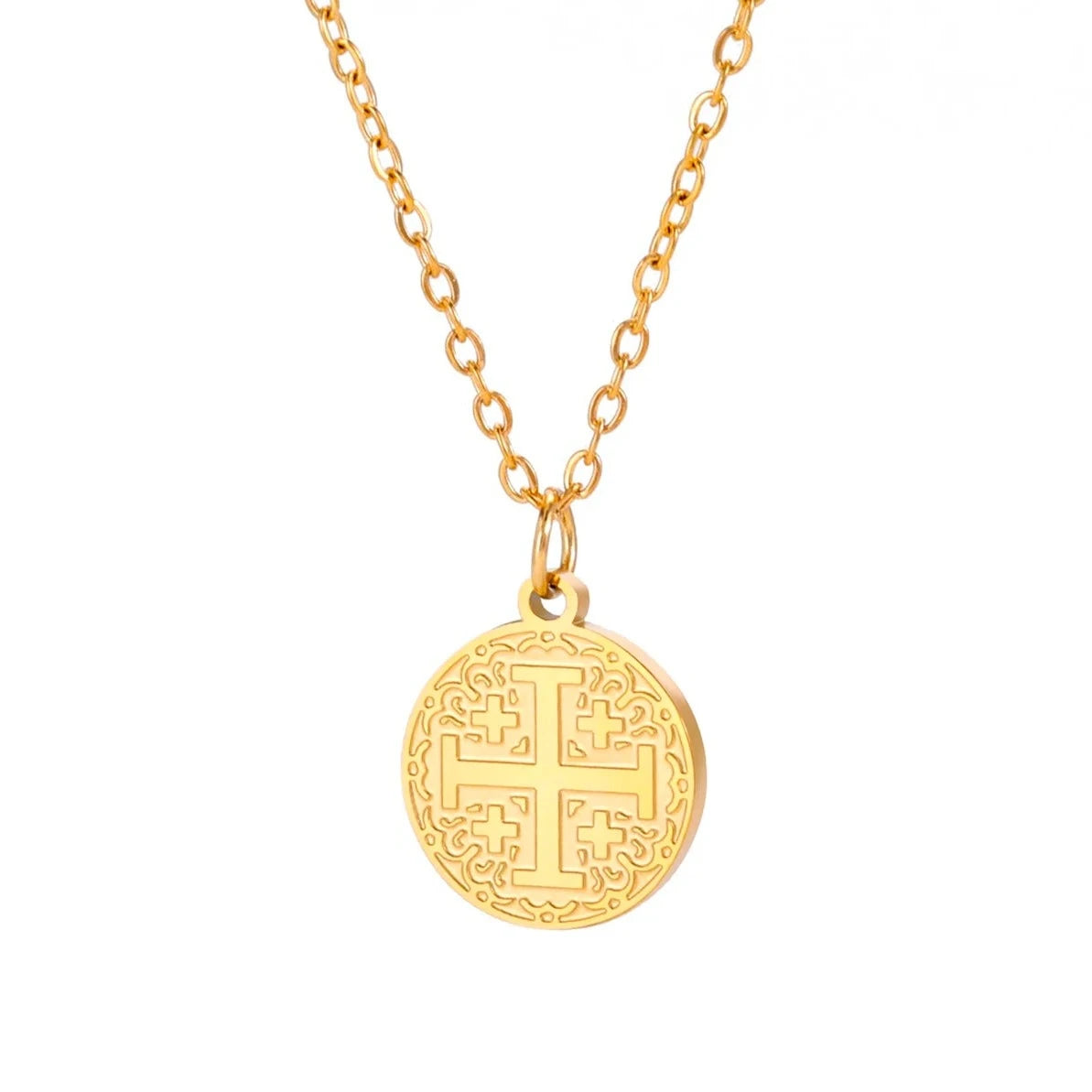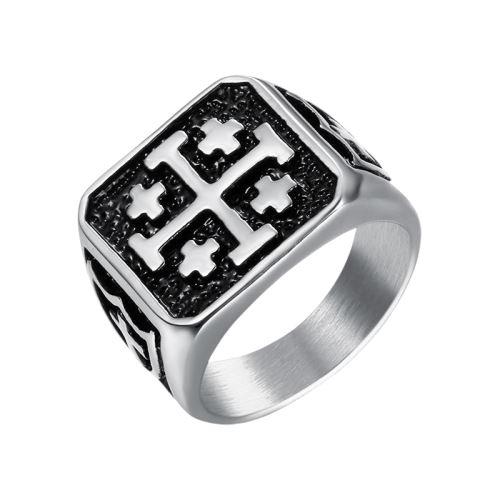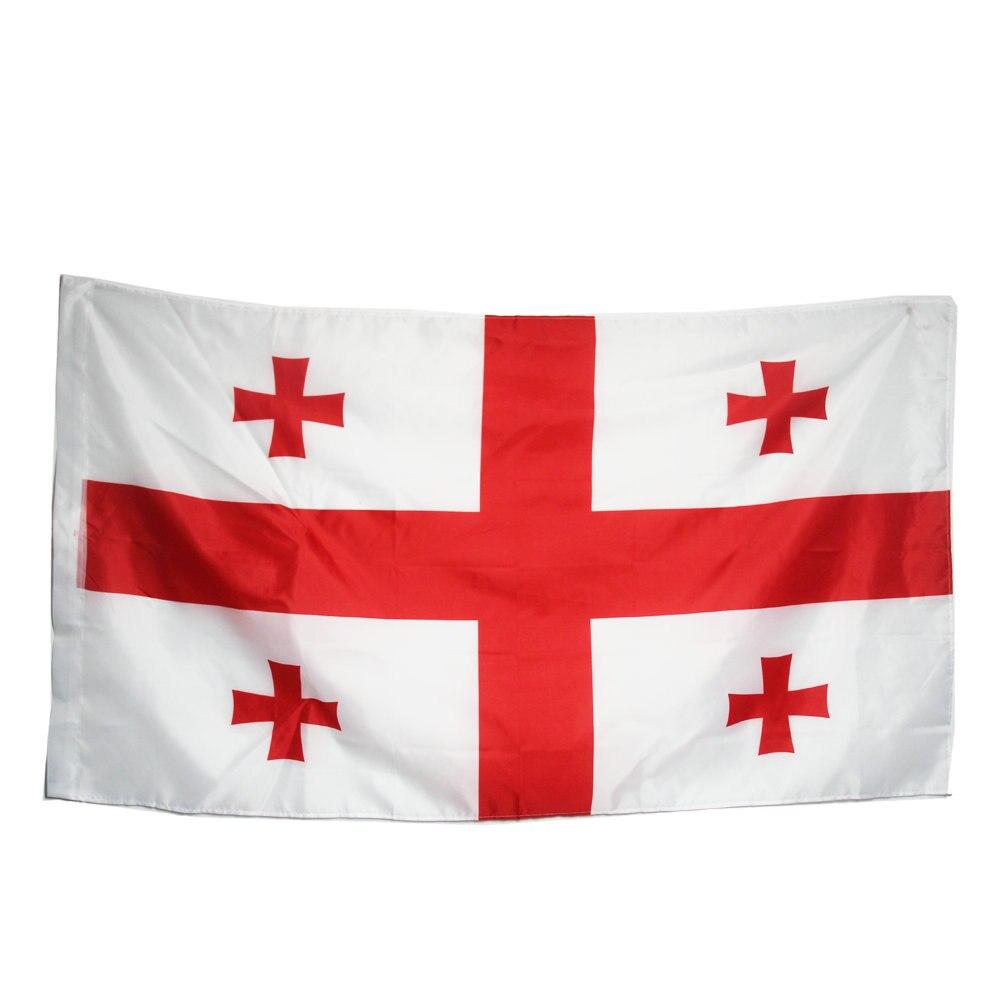In-depth Study On the Jerusalem Cross
The Jerusalem cross is a powerful Christian good luck charm.
This symbol is made up of five crosses with branches of the same length, a central one and four smaller ones placed in each of the quadrants of the first.
Its name does not come from nowhere: this variant of the Christian cross was notably used as an emblem and coat of arms of the Kingdom of Jerusalem from the end of the 13th century.
Between history, meaning and powers (symbolic as well as spiritual), let's now focus on the Jerusalem cross!
Contents :
The origins of the Jerusalem cross
Some uses of the Jerusalem cross
The meaning of the Jerusalem cross
The duty to spread the good news to the four corners of the world

The origins of the Jerusalem cross
While the symbol of the Jerusalem cross itself appears to originate from the 11th century, its association with the Holy Land only dates from the period of the Crusades.
The idea of using this lucky cross as the coat of arms of the newly created state is traditionally attributed to Godfrey of Bouillon, the first ruler of Jerusalem.
However, not all kings used it. The arms of Jean de Brienne, for example, who ruled from 1210 to 1212, consisted only of a simple silver Christian cross on a gold background.
Other sovereigns subsequently made the cross we are talking about here their personal emblem.
We can therefore easily imagine kings wearing this type of amulet representing their symbol: the Jerusalem cross.

Some uses of the Jerusalem cross
The symbol of the Jerusalem cross has seen many uses since its creation.
We will now list a few that should interest all history buffs!
The Jerusalem cross to mint coins
From 1158 to 1180, King Henry II of England ordered coins called “Cross-and-Crosslets” to be minted.
Legend has it that he found a signet ring of this type (no one knows exactly what it looked like, but we do know that it bore the Jerusalem cross) during the crusades in which he participated.
He found it so exceptional, of such perfect beauty, that he decided to include the symbol it bore in the long list of emblems of the crown of England.
In short, the design of these pieces was based on a model of a Jerusalem cross but with the four small crosses placed diagonally.
Besides this, the coins struck for the city of Jerusalem from the end of the 12th century did not necessarily use this Christian cross as the seal of the city.
Monuments such as the Tower of David, the Dome of the Rock and the Holy Sepulcher were also used.
It was in fact only during the reign of John II (1284 - 1285) that the minted coins almost all used this Christian lucky symbol.
A common religious symbol in heraldic art
The Christian cross in general is a very common theme when it comes to flag making, in fact there are thousands of variations.
We are therefore not going to make an exhaustive list here, but simply cite a few examples which will illustrate a fact: in reality, the Jerusalem cross was not the prerogative of the Crusader States.
Here are some examples of use of this lucky cross:
- By the end of the medieval period, the Jerusalem cross would have been used for various Christian states in the Near East.
- The "Book of All Kingdoms", a 14th century work, uses it as the flag of Sebasteia (a province of the Byzantine Empire).
- Around the same time, Pizzigano's map employs it as the flag of the Georgian city of Tbilisi.
- Carlo Maggi, a Venetian notable who visited Jerusalem and was knighted in the Order of the Holy Sepulcher in the early 1570s, also included the Jerusalem cross in his coat of arms.
- There is a legend that Peter the Great, a well-known Russian emperor, flew a flag with a variation of the Jerusalem cross during his White Sea campaign in 1693.
Modern use of the Jerusalem cross
Even today, the Order of the Holy Sepulcher uses the Jerusalem cross as the emblem of their organization.
It is also used by the Franciscan Custody of the Holy Land, a Catholic organization that ensures the preservation of holy sites in Jerusalem and Judea.
At the beginning of the 20th century, the Jerusalem cross also became a symbol of evangelization in certain currents of Protestantism.
One of the most famous recent examples is the "Episcopal Church Service Cross" which was first used during World War I by the Anglican Church in the United States.
In the 1950s, the Congress of the German Evangelical Church decided to also use the Jerusalem cross as a symbol of their community.
The current flag of Georgia (the meaning of which you can discover here), introduced in 2004, also features this type of lucky cross.
The meaning of the Jerusalem cross
Through this association with the Crusades, the Jerusalem Cross is known as the Crusader Cross.
Besides this, however, there are other interpretations that have been proposed to define the true meaning of the Jerusalem cross.
The five wounds of Christ
“ But one of the soldiers pierced his side with a spear, and immediately there came out blood and water. » - John 19:34
The Jerusalem cross is sometimes seen as representing the five sacred wounds of Christ.
The powerful central cross is associated with the wound made to Jesus' ribs on his side, where the soldier pierced him.
The four smaller crosses then represent the wounds on Jesus' hands and feet made by the nails that were used to fix him to the cross.
This way of interpreting the meaning of the Jerusalem cross makes it a beautiful reminder of the Lord's sacrifice and the price He had to pay to be able to save us.
It is therefore a Christian lucky charm to be placed alongside the older ones (that's good, we have unearthed them for you!).
Christ and the four evangelists
Another interpretation given to the Jerusalem cross is the following: it actually represents Christ and the four evangelists (namely Matthew, Mark, Luke and John).
The centrality of Jesus means that he is the core of the Gospel and that what the four evangelists wrote really concerns the Lord.
It is sometimes sad to see that some people forget what constitutes the essence of the Christian religion, and sometimes willingly place material things there.
As believers, the Jerusalem cross reminds us of the centrality of Jesus in our lives and the importance of the Gospel message in our daily lives.
This way of considering this model of the Christian cross shows us the importance of announcing the Good News to everyone. This is therefore an interpretation which should particularly please missionaries and evangelists.
img class="lazyload" height="576" width="1024" src="https://cdn.shopify.com/s/files/1/0254/1564/7309/files/Iphone-spinner-1.gif " id="balise_3bis">
The duty to spread the good news to the four corners of the world
“ But you will receive power when the Holy Spirit has come upon you, and you will be my witnesses in Jerusalem, and in all Judea, and in Samaria, and to the ends of the earth ” - Acts 1:8 (here's one depth study)
In ancient times, people thought the world was flat and therefore limited. Traveling too far was then seen as the risk of “falling out of the world”…
This sets a context which allows us to give a third interpretation to the cross of Jerusalem: the center would again be Christ, but the four quadrants would here be associated with the four quarters of the world.
Jesus indeed ordered his disciples to preach the Gospel in four specific places.
Jerusalem
It was in Jerusalem that some of the most important events in the lives of Jesus and his disciples took place.
This is the place where Jesus was crucified and resurrected.
In the context of spreading the Gospel, Jerusalem represents our family or the people closest to us. This is the place where we come from.
Sharing Jesus and his gift of eternal life must be shared above all with our family and loved ones.
Judea
Judea could represent our close circles (neighborhood, colleagues, classmates, friends).
Yes, God also gave us the task of sharing our faith with the people around us.
Samaria
Samaria is a region that enjoyed a certain reputation during the 1st century in Israel, particularly because it was there that the Samaritans came from.
Anyone who has read the Bible knows that Jesus did not really have a good relationship with these individuals.
Given Jesus' command to go and preach even in Samaria, we could say that it is our duty to share our faith even to those we do not like.
At the ends of the Earth
Finally, Jesus charged his disciples to go to the ends of the earth.
There is probably no figure of speech here: God wants us to spread the Gospel even to the most distant places on the planet.
Certain individuals also receive this gift of evangelization and are called to be missionaries.

Conclusion
The Jerusalem cross is undeniably an important Christian good luck charm.
Throughout the ages, different variations have been used by a multitude of people and organizations.
Its weight during the Crusades was far from negligible, and this cross still serves today as an emblem of certain branches of Christianity.
Its meaning has also undergone multiple evolutions and, even today, several interpretations are acceptable.
Whichever view we take, the Jerusalem cross remains (and will remain) a powerful symbol of Christ and the Christian religion.
As such, it has earned its place among the most important Christian crosses of all time!
Lucky charms featured in this article

Amulet with a Jerusalem Cross
See more
Signet Ring with the Jerusalem Cross
See more
Flag of Georgia
See more

